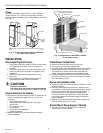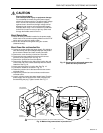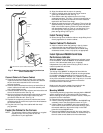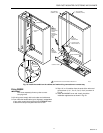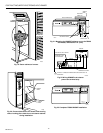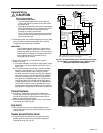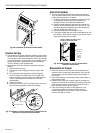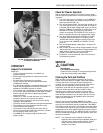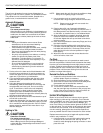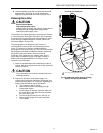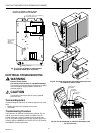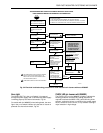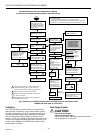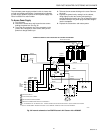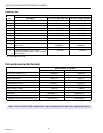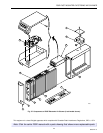
F50E DUCT MOUNTED ELECTRONIC AIR CLEANER
68-0072—5
16
The cells can be washed in many home dishwashers, by
soaking in a tub or at a do-it-yourself, coin-operated car wash.
The prefilters can be vacuumed, brushed, sprayed with a
garden hose, or washed with the electronic cells
Automatic Dishwasher
CAUTION
Burn Hazard.
Can cause personal injury.
Allow the cells to cool completely in the dishwasher at
the end of the wash cycle or wear protective gloves to
avoid burns. Hot water can accumulate in the tubes
supporting the collector plates; tip the cells so these
tubes drain.
IMPORTANT
• Check your dishwasher owner manual. Some
manufacturers do not recommend washing
electronic cells in their dishwashers.
• If the dishwasher has upper and lower arms, carefully
position the cells to allow good water circulation.
• Use care to avoid damaging the cells when placing
them in the dishwasher.
• Very dirty cells, especially from tobacco or cooking
smoke, can discolor the plastic parts of the
dishwasher. This discoloration is not harmful. To
minimize it, wash the cells more frequently or try a
different brand of detergent.
• Do not allow the dishwasher to run through the
dry cycle. This bakes on any contaminants not
removed during the wash cycle and reduces air
cleaner efficiency.
1. Put the cells on the lower rack of the dishwasher with
the airflow arrow pointing up. It may be necessary to
remove the upper rack. Do not block water flow to the
upper arm, if provided on your dishwasher.
2. If you are washing the prefilters with the cells, place
them where they will not block the water flow to the
electronic cells.
3. Using the detergent that works best for normal
dishwashing, allow the dishwasher to run through the
complete wash and rinse cycle. Do not use the dry
cycle. To avoid burns, let the cells cool completely
before removing, or wear protective gloves when
removing the cells. Remember that water may be
trapped in the tubes that support the collector plates; tip
the cells so these tubes can drain.
4. Wipe each ionizer wire and red contact board on top of
the cell with a clean cloth.
5. Inspect the dishwasher. You may want to rerun the wash
and/or rinse cycle with the dishwasher empty if you see
dirt or residue from washing the cells. If dirt or residue
seems excessive, wash the cells more often or try a
different detergent.
Soaking in Tub
CAUTION
Hazardous Chemical.
Can cause personal injury.
Do not splash the detergent solution in eyes.
Wear rubber gloves to avoid prolonged detergent
contact with skin. Keep detergent and solution out of
reach of children.
NOTE: Always wash the cells first, then the prefilters to keep
heavy lint from getting caught in the cells.
1. Use a container such as a laundry tub or trash
container that is large enough to hold one or both cells.
NOTE: Sharp corners on the cells can scratch the
surface of a bathtub.
2. Dissolve about 3/4 cup of automatic dishwasher
detergent in enough very hot water to cover the cells. If
the detergent does not dissolve readily, or forms a scum
on the water, try another brand, or use softened water.
3. After the detergent is completely dissolved, place the
electronic cells in the container and let soak for 15 to
20 minutes. Agitate the cells up and down a few times
and then remove.
4. Next, wash the prefilters the same way. Empty and rinse
the wash container.
5. Rinse the cells and prefilters with a hard spray of very
hot water; rinse the tub clean then fill the tub with clean,
hot water and soak for 5 to 15 minutes. Rinse until the
water draining from the cells and prefilters no longer
feels slippery.
6. Wipe the ionizer wires and red contact board on the
end of cell with a clean cloth.
Car Wash
Use the hand sprayer at a coin-operated car wash to wash
the cells and prefilters. Hold the nozzle at least two feet away
from the unit to avoid damage from the high pressure stream
of water. Follow the same sequence of wash and rinse as
recommended for cars. However, do not wax the cells or the
prefilters. Rinse until the water draining from the cells and
prefilters no longer feels slippery.
Reinstall the Cells and Prefilters
1. Inspect the cells for broken ionizer wires and bent
collector plates. Repair as necessary.
2. Slide the prefilters into the upstream prefilter guides.
3. Slide in the air cleaner cells so the air flow arrow points
downstream and the handles face outward.
4. Firmly close the access door.
5. Turn on the air cleaner. If the cells and prefilters are
wet, the neon light may not come on and you may hear
arcing. If the arcing is annoying, simply turn off the air
cleaner for two to three hours, or until dry.
Ionizer Wire Replacement
Broken or bent ionizer wires can cause a short to ground,
often resulting in visible arcing or sparking. On air cleaners
without a W8600E, any short in the ionizer section causes the
neon light to go out. On air cleaners with a W8600E, any
short in the ionizer or collector section lights the CHECK LED
on the wall panel. The cell should not be used until the pieces
of broken wire are removed. It can be used temporarily with
one wire missing, although the wire should be replaced as
soon as possible. See the Parts List section for order number.
Replacement wires come cut to length with eyelets on both
ends for easy installation. To install:
1. Hook the eyelet on one end of the wire over the spring
connector on one end of the cell. See Fig. 30. Be
careful to avoid damaging the spring connector or other
parts of the cell.



